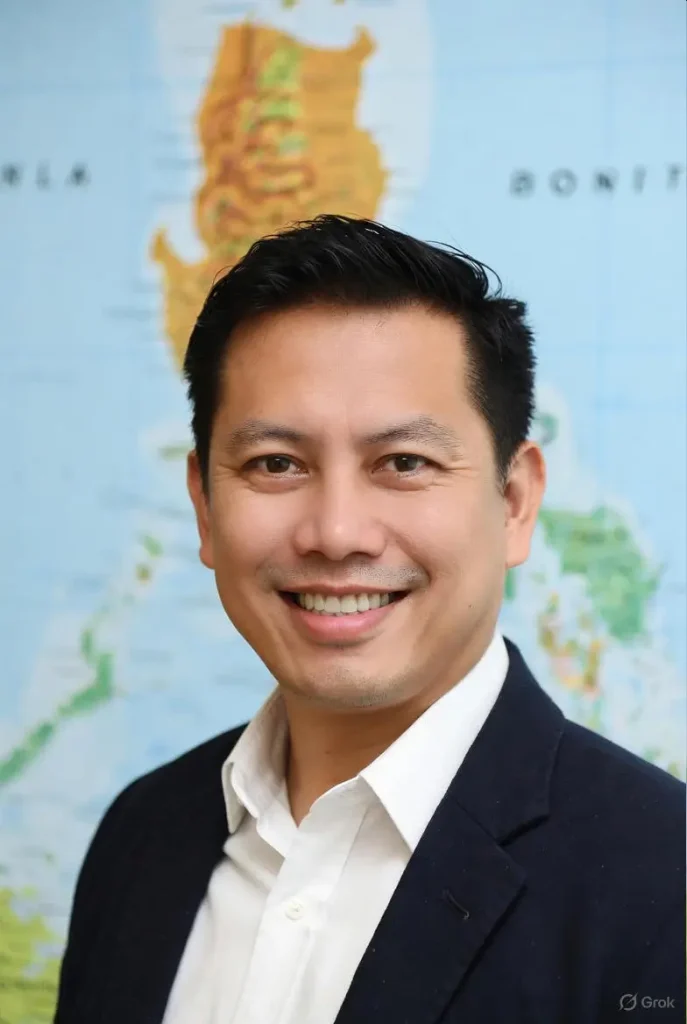
Robert T. Wagner, JD
Clark Field
Nov. 10th, 2025
In arguably one of the most turbulent periods of internal political conflict in its history, the influence of elite families controlling the economy would decline dramatically in the event of the Philippines breaking up into eight new nations, while creating new and greater possibilities for those in the legal profession.
Held Together, Artificially
The Philippines, an archipelago of over 7,000 islands, is a nation of profound cultural and ethnolinguistic diversity. Home to more than 182 ethnolinguistic groups, the country has long navigated tensions between unity and regional identities. While the 1987 Constitution enshrines national sovereignty and territorial integrity, scenarios of political fragmentation, such as a breakup into independent states along major tribal or ethnolinguistic lines, raise profound questions about governance, identity, and the rule of law.
Currently in hushed discussion outside the halls of Imperial Manila is a potential division of the country into as many as eight sovereign nations, delineated by predominant ethnolinguistic clusters. Drawing on the current legal framework and historical precedents from global partitions, such as the former Yugoslavia and Timor L’este, this topic characterizes both disruptions and opportunities facing Filipino lawyers.
As of this writing such a scenario is purely hypothetical, intended only to illuminate the fragility of unified legal institutions in diverse societies. It underscores the role of the IBP (Integrated Bar of the Philippines) in fostering national cohesion, as regulated under the Supreme Court’s oversight. Thus far, secessionist movements, such as those in the Bangsamoro region, have been addressed through autonomy rather than dissolution, highlighting the preference for federalism over fragmentation.
In the wake of the current corruption scandals and the likelihood of a second Duterte presidency in 2028, however, that may be about to change.
The Current State of the Profession
The Philippine legal system is a hybrid of “Derecho Civil” (Civil Law – inherited from the Spanish) and Common Law (from American influence), with the 1987 Constitution as its cornerstone. Lawyers, numbering over 120,000 as of recent estimates, are admitted to practice through the IBP. which unifies the profession, mandating ethical standards, continuing legal education via the Philippine Judicial Academy (PHILJA), and pro bono service across the archipelago.
Admission requires a law degree from an accredited school, passing the Bar Examination, and taking an oath before the Supreme Court. Practice is unitary: a lawyer licensed in Manila can appear in Davao courts without reciprocity barriers. This national framework supports mobility, standardization, and access to justice in a unitary republic.
However, regional customary laws, particularly among indigenous peoples (IP’s) and Muslim Filipinos, coexist, as recognized under the Indigenous Peoples’ Rights Act (IPRA) and the Code of Muslim Personal Laws. Interruption to this unity would impose a disconnect from such ancillary realms.
Mapping the New Nations
Under the fragmentation scenario, a negotiated partition into eight sovereign states based on major ethnolinguistic distributions is envisioned, based on the 2020 Census of Population and Housing. These lines approximate historical, cultural, and demographic environments, though origin tribal affiliations are fluid and overlapping:
- Ilocandia (Northern Luzon): Dominated by Ilocanos, including Cordillera IP groups like the Ifugao, Igurot and Kalinga, and absorbing Isabela and Pangasinan. Capital: Laoag or Baguio.
- Tagalog Republic (Central and Southern Luzon): Centered on the Tagalog ethnic group, absorbing Pampanga (potential to join Ilocandia), Aurora, Bicol (itself a candidate for secession), Mindoro and Palawan. Capital: Manila.
- Kabisayaan (Cebu and Eastern Visayas): Led by Cebuano speakers, extending to Samar (Waray) and Leyte (Bisayan). Capital: Cebu City.
- Hiligaynon Confederation (Western Visayas): Focused on Ilonggo/Hiligaynon, including Ati and other origin tribes on Negros and Panay. Capital: Iloilo.
- Oriental Mindanao (North, Central and Eastern Mindanao): Predominantly Cebuano/Bisaya groups, including origin tribes such as the Bukidnon and Manobo. Capitol: Cagayan De Oro (CDO).
- BARMM (Mindanao and Sulu): Encompassing Moro groups Maguindanao, Maranao, Tausug and Lumad tribes (e.g., Manobo, T’boli; ~13 groups). Capital: Cotabato or Zamboanga.
- Republic of Davao (Combined Norte and Sur): Ancestral Cebuanos (Dabawenyo dialect) with origin tribes of Bagobo, Tagabawa, and Bagobo Klata, with total land area larger than that of Brunei.
Side Note: This division ignores the Bisaya/Binisaya umbrella (14.3%), which spans Visayan states, and smaller IPs (9.1% of the population), potentially leading to enclaves and disputes. A transitional treaty, akin to the 1993 Czech-Slovak “Velvet Divorce”, would allocate assets, debts, and citizenship, and rightful independence would follow swiftly.

Regulatory and Practical Challenges
A partition would dismantle the centralized regulation of lawyers, mirroring challenges in historical secessions. The Manila IBP’s detachment would necessitate seven new bar associations or authorities, each with independent admission, ethics, and disciplinary bodies. Currently, the Supreme Court enforces uniformity; post-division, each new nation might adopt divergent standards, initially complicating cross-border practice but potentially creating room for a commonwealth-style system.
New Licensing and Qualification Standards
Lawyers would face mandatory re-qualification in their “home” states, based on residency or ethnicity. Degrees from Philippine law schools (e.g., University of the Philippines, Ateneo) might be grandfathered, but foreign-trained lawyers (common in urban areas) could be required to sit for equivalency exams. In the Moro-Lumad Confederation, Sharia-influenced qualifications might prioritize Islamic jurisprudence, sidelining civil law specialists.
This echoes the post-1947 India-Pakistan partition, where over 10,000 lawyers migrated and re-registered amid communal violence, delaying practices for years. It should be mentioned that, while not directly cited, historical parallels from available partition literature supply Prima facie data for this analogy.
Restrictions on Interstate Mobility and Practice
The unitary license would vanish, replaced by reciprocity treaties, likely limited due to inter-state rivalries. For instance, a Tagalog lawyer litigating in Ilocandia might need local co-counsel or pro hac vice admission, increasing costs and delays. In the U.S. Civil War secession (1861), Confederate lawyers were disbarred in Union states, fracturing networks; reintegration post-1865 required loyalty oaths. Filipino lawyers, often migratory (e.g., from provinces to Manila firms), might initially see career disruptions, particularly in corporate law spanning Visayas-Mindanao trade.
Revision of Court Systems and Legal Education
The judiciary, currently hierarchical under the Supreme Court, would most likely continue in similar forms under the new flags. Regional Trial Courts would become national apex bodies, with appeals limited domestically. PHILJA’s mandatory education model would be revised and reinvented to suit concurrent environments.
The New Tagalog Republic might retain American-style bar exams, while the BARMM integrates madrasah curricula. As an example, the 1993 Czechoslovakia split required dual bar retraining, causing an initial 20% drop in active lawyers, recovering to pre-division numbers within a year later.
To gain diplomatic and economic benefit from the international community, except for the New Tagalog Republic and the BARMM, most states would probably adopt peer-jury systems and allow land ownership by foreigners, inviting in a rush of new, out-of-country clients for lawyers therein.
Economic and Ethical Ramifications
Ethics codes would diverge. Stricter anti-corruption rules in Kabisayaan versus customary dispute resolution in Lumad areas. Pro bono obligations, an IBP pillar, might narrow to intra-state aid, reducing national access to justice.
| Aspect | Pre-Partition Philippines | Post-Partition (Eight States) Example |
| Licensing | National bar exam; IBP membership | State-specific exams; ethnic/residency prerequisites |
| Mobility | Free practice nationwide | Reciprocity treaties; pro hac vice fees |
| Education | PHILJA-mandated CLE | Localized programs; potential curriculum splits |
| Ethics/Discipline | Supreme Court oversight | Independent state bars; varying standards |
| Economic Impact | Integrated market (e.g., Manila firms) | Localized practices; migration of talent |
Opportunities and Adaptations
Amid chaos, opportunities generally emerge. Localized bars might better incorporate customary laws, empowering IP lawyers in the Ilocano or Lumad states – aligning with IPRA’s spirit. International law firms could pivot to treaty negotiations, boosting expertise in public international law. Historical precedents, like post-Soviet republics where lawyers formed cross-border guilds, suggest rapid adaptation through professional networks.
Filipino lawyers, schooled in resilience from the martial law era, could lead transitional justice commissions, drafting constitutions and human rights charters. A strict application of English in all documentary and court proceedings, with movement away from local languages, would prove invaluable for international recognition and reputation of the new legal systems.
A breakup of the Philippines into eight ethnolinguistic nations would profoundly change the legal profession as it has thus far existed in the archipelago, at once echoing the upheavals of global partitions like India-Pakistan or Czechoslovakia, yet forming better, stronger, more just legal environments that were not available to average people in the past.
It would catalyze innovation, urging lawyers to bridge divides through international norms and customary wisdom rather than muddling forward in the corrupt machinery of the “juicio sin jurado” aka. Bench Trial (single judge with no jury) system introduced and perpetuated by the Spanish though modern times. It should also be noted that the IBP’s unity is not merely administrative, but a bulwark against division.


